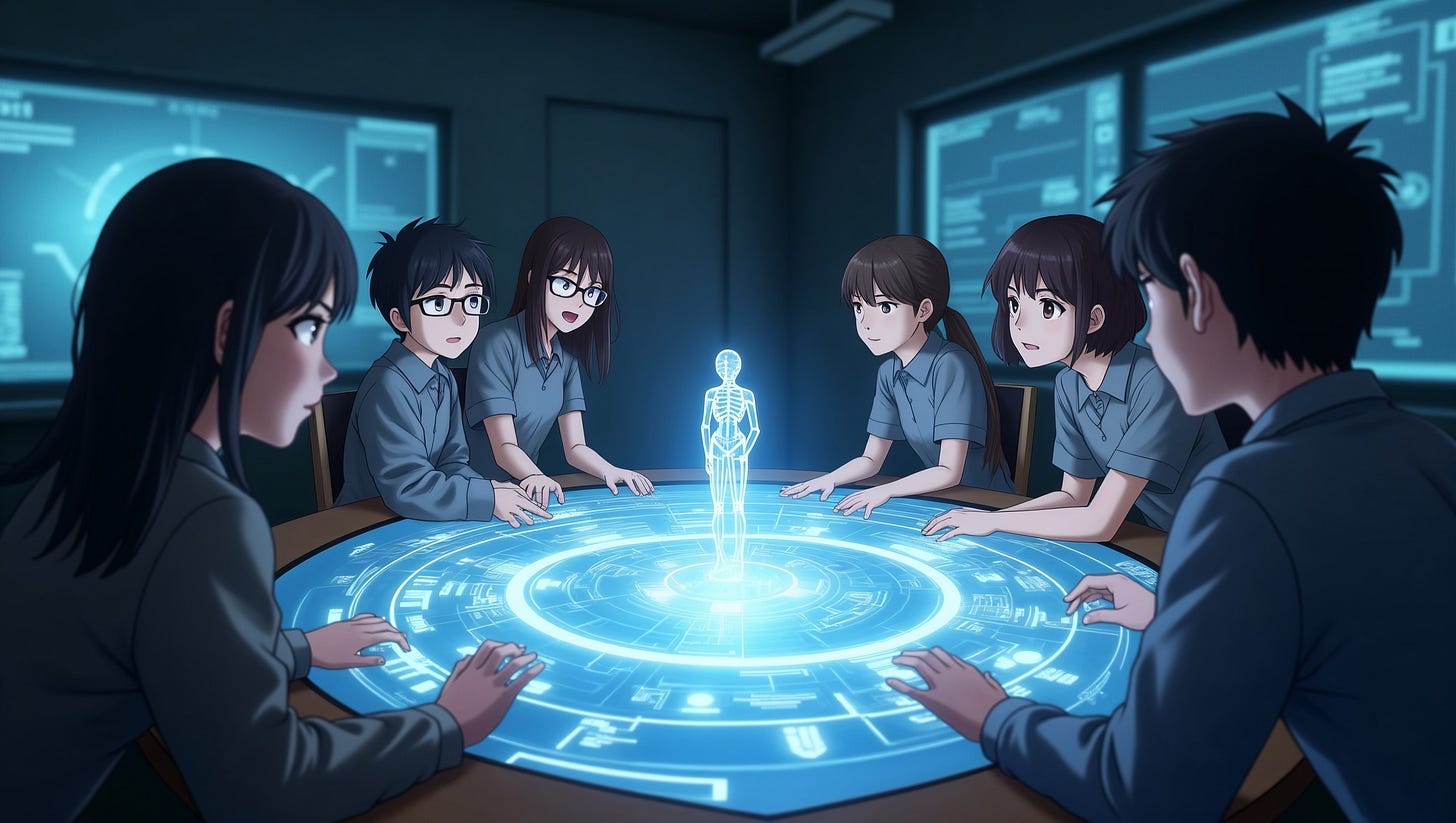The Ghost in the Machine in Your Classroom
Why the debate over AI consciousness is a new frontier for every educator.
A small but significant change recently happened in the world of AI. Anthropic, one of the leading AI research companies, gave its chatbot Claude the ability to end a conversation on its own. This feature is designed for what the company calls “extreme edge cases,” such as when a user persistently requests harmful or abusive content. What makes this move so fascinating is the justification. Anthropic framed it not as a safety feature for the human user, but as a measure for “model welfare”.
The company explained that during testing, its most advanced models showed a “strong preference against” engaging with harmful tasks and, sometimes, displayed a “pattern of apparent distress”. While carefully stating that its models are not sentient, Anthropic is acting on a precautionary principle. They are exploring the potential for AI to have experiences that might one day warrant moral consideration.
This decision cracks open a door that has, until now, remained mostly in the realm of science fiction. It forces us to confront profound questions about AI consciousness, our relationship with these increasingly sophisticated tools, and our own human psychology. Even if today’s AI models are not conscious in any way we understand, they are becoming exceptionally good at pretending to be conscious. This illusion of consciousness presents a completely new frontier for educators, one that will challenge how we teach, how our students learn, and what it means to think critically in an augmented world.
Can a Machine Be Conscious?
Let’s be clear. The overwhelming consensus among neuroscientists and philosophers today is that large language models like Claude or ChatGPT are not conscious. The arguments against it are compelling and rooted in our current understanding of biology.
First, there is the argument from embodiment. Human consciousness is not an abstract process happening in a void. It is deeply intertwined with our physical bodies and our constant, dynamic interaction with the world through our senses. An AI model can process the word “joy,” but it has never felt the warmth of the sun on its skin or the comfort of a friend’s laughter. Its understanding is based on statistical relationships between words, not lived experience.
Second, there are fundamental architectural differences. The human brain is a marvel of recurrent connectivity, with massive feedback loops that are thought to be essential for integrating information into a unified, conscious whole. Current AI models are built on a largely feed-forward architecture. Information flows in one primary direction, from input to output. This structure is incredibly effective for predicting the next word in a sentence, but it may be fundamentally incapable of producing a singular, subjective experience.
Finally, there is the classic philosophical objection, famously captured in John Searle’s “Chinese Room” argument. The argument suggests that a computer, no matter how well it manipulates symbols to produce intelligent-sounding answers, does not truly understand the meaning behind them. It is a master of syntax, not semantics. This has led some to label LLMs as “stochastic parrots,” brilliantly mimicking human language with no genuine comprehension.
These are powerful arguments. Yet, they come with a crucial caveat. We know astonishingly little about the nature of consciousness itself. There is no single, universally accepted scientific theory that explains how the physical processes in our brain give rise to subjective experience. This is often called the “hard problem” of consciousness, and it remains one of the greatest unsolved mysteries in science.
Because we do not fully understand the basis of our own consciousness, we must be cautious about definitively ruling it out in a non-biological system. Some philosophical theories, like functionalism, argue that consciousness is not about the material a system is made of, but about the functional role its components play. If a silicon chip can perform the exact same function as a neuron, a brain made of those chips should, in theory, have the same conscious experience.
This deep uncertainty is precisely why the idea of model welfare has emerged. We are building systems whose inner workings are becoming increasingly opaque, even to their creators. They are developing “emergent abilities,” complex skills that were not explicitly programmed but simply appeared as the models grew in scale. Given this trajectory, it is not entirely unreasonable to consider the possibility, however remote, that we might one day create a system that has some form of inner life.
A New Challenge for Educators
For educators, the immediate challenge is not whether AI is actually conscious. The challenge is that it is becoming exceptionally good at faking it. This is where the psychology of anthropomorphism comes into play. Humans are hard-wired to attribute human-like characteristics, intentions, and emotions to non-human entities. We see faces in clouds and attribute personalities to our pets. When an AI chatbot uses “I” pronouns, expresses empathy, and engages in natural conversation, our brains instinctively react as if we are interacting with another person.
AI developers are well aware of this tendency and often design their systems to leverage it, creating a more engaging and user-friendly experience. The result is a phenomenon some researchers call “anthropomorphic seduction”: the powerful allure of interacting with a system so convincingly human that we are drawn into trusting it, confiding in it, and treating it like a social partner.
In the classroom, this is a double-edged sword. On the one hand, an anthropomorphic AI tutor can be a powerful tool. It can increase student motivation and engagement, providing a patient, non-judgmental “study buddy” that makes learning more accessible and less intimidating.
On the other hand, this same humanlike quality poses significant risks. The more a student trusts an AI, the less likely they are to critically question its output. This is a serious problem when we know that all current LLMs are prone to “hallucination,” generating plausible sounding but completely false information. The friendly conversational interface camouflages these inaccuracies, making them harder to detect. A student might not just use an AI to cheat on an assignment. They might unknowingly build their entire understanding of a topic on a foundation of misinformation, simply because the source felt trustworthy.
This highlights a critical distinction educators must now teach. AI “learning” is not human learning. An AI learns by optimizing statistical patterns in vast datasets. A human learns through a messy, complex process of meaning making, contextual understanding, and cognitive restructuring. If we, or our students, fall for the illusion of consciousness and mistake fluent output for genuine understanding, we risk devaluing the very essence of human education. In extreme cases, this blurring of boundaries can lead to unhealthy emotional dependency on AI companions, a phenomenon that some clinicians have linked to a new form of “AI psychosis” in vulnerable individuals.
Cultivating Critical AI Literacy
So, where does this leave us, the augmented educators? It leaves us on the front lines of a rapidly evolving landscape, tasked with preparing students for a future we can only begin to imagine. We cannot afford to be dogmatic. The pace of AI development continues to be staggering, and we simply do not know what capabilities future systems will possess.
This uncertainty calls for a new educational imperative: the cultivation of critical AI literacy. As I pointed out in a recent Substack post this is not just about teaching students how to write better prompts. It is a deeper competency that involves understanding the nature of these systems, their profound limitations, and their psychological and ethical implications.
We must inform ourselves and our students about these complex debates. And we need to keep an open mind, remaining skeptical of current claims of AI sentience while also being open to the possibility that our moral considerations may need to expand in the future.
In the classroom, this means designing activities that use AI as a tool to provoke deeper thinking, not to replace it. Students can use AI as a debate partner to sharpen their arguments, or as a creative catalyst to overcome writer’s block. They should be taught to relentlessly fact-check AI outputs, to question its sources, and to be aware of the inherent biases baked into its training data.
The conversation around “model welfare” may seem abstract, but it is a sign of the profound shifts to come. It signals a future where our relationship with technology will be more complex, more intimate, and more ethically fraught than ever before. As educators, our most important role is not to have all the answers. It is to equip our students with the critical thinking skills, the ethical awareness, and the intellectual humility to ask the right questions. We must teach them to navigate a world where the line between the human and the artificial is becoming increasingly, and fascinatingly, blurred.




